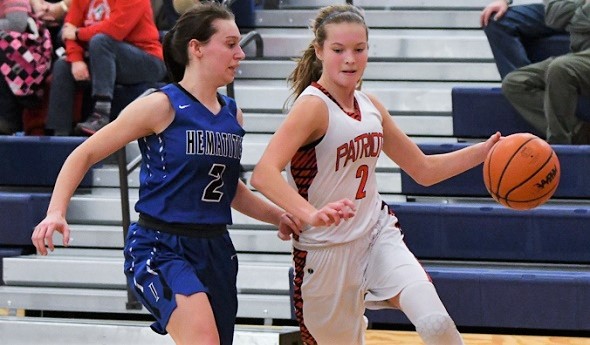
Westwood Sets Sights on Past Heights
December 20, 2018
By Dennis Grall
Special for Second Half
ISHPEMING – The Westwood Patriots do not have a senior on their girls basketball roster and only two players stand as tall as 5-foot-9.
 But don’t overlook this team.
But don’t overlook this team.
Five juniors who played extensively a year ago provide the leadership and experience, while two sophomores and a promising freshman show excellent potential in the challenging Mid-Peninsula Conference. And they play for a team that is steeped in tradition and success, including a 2003 Class C championship.
Kurt Corcoran, a former Westwood cager, is in his seventh season as head coach. His assistant coach is Irv Dieterle, who is second in the Upper Peninsula among boys basketball coaches with 555 wins. Corcoran played for Dieterle in the 1990s.
“Irv is one of my very best friends in life now,” said Corcoran. “At times I was so angry and frustrated with him as a teenage boy. Now we can sit over a cup of coffee and laugh and laugh and laugh.
“I have the best assistant coach possibly in the nation. I feel very privileged to have him as a friend, assistant and mentor.”
Dieterle provides suggestions at halftime or when asked on the bench. “I would be crazy not to heed his advice,” said Corcoran, who is in charge of this team.
With the lack of size, the Patriots use solid defense and rely heavily on the shooting skills of junior Madi Koski, a three-year starter who was all-conference and All-U.P. as a freshman. In their most recent game, Dec. 18, Koski scored 21 points and hit two 3-point baskets to help subdue Gladstone 50-32.
“Madi is a stone-cold killer when it comes to scoring,” said Corcoran. “I’ll put her shot up against anybody (in high school).”
Her sister Jillian is a freshman with outstanding promise playing like most freshmen riding the roller coaster of success and mis-adventures. She did not score against Gladstone but had 17 points against archrival Ishpeming on Dec. 10.
“They are not the same player. Jillian will sacrifice her body, but Madi is a little more reserved diving into those (piles of) bodies,” said Corcoran. “(Jillian) is a real good ball handler, probably one of the best I’ve seen, but she needs to get stronger and catch up to the speed of the game.”
Jillian Koski has been a point guard since forever but is now at shooting guard, with her sister at the point. “(Jillian) is not on anybody’s radar yet (but) she is catching up with the speed of the game. That takes at least 10 games,” said Corcoran. “She lets the game come to her. Madi has to score. Madi facilitates the game. She wears many hats (scoring, passing, defending).”
 He said the young sisters “really have just one goal in common, and that is to win.”
He said the young sisters “really have just one goal in common, and that is to win.”
Corcoran is trying to restore Westwood to the level of long-ago years when the Patriots were always among the Upper Peninsula’s elite teams under veteran coach Tom Hammar (nearly 400 career wins) and with such standouts as Sarah Stream and Megan Manninen, who both played in the Great Lakes Intercollegiate Athletic Conference for Michigan Tech and Lake Superior State, respectively. Jessica Racine also played at Tech, and Chelsea Wealton was another standout.
Two years ago, the Patriots beat unbeaten Norway and all-stater Jordan Kraemer, and last year they beat unbeaten neighbor Negaunee in the District opener. Negaunee and Westwood, two of the best teams in the peninsula this season, will collide in the tourney opener in March after two regular-season league matchups.
“With the guard play we have now and in the future, our goals are set high,” said Corcoran. “But we have to get past that first game to even get out of Districts. I’d be lying if I didn’t say we have our sights set on making a run downstate. They have paid their dues; they want a state championship. That is not a secret, but that is also Negaunee’s goal and West Iron’s goal. That is everyone’s goal.”
Reaching that height would be a big change from where the Patriots were a couple of years ago. The Pats were 5-15 when Madi Koski and fellow junior standout Tessa Leece were in eighth grade.
“As freshmen, they came to a struggling program that had been down in the dumps. They were given the keys to the Cadillac as young teenagers and they really were not ready,” said Corcoran.
But the two frosh made an immediate impact and Corcoran said “from that moment forward the program took a turn for the better. They got to 12 wins and beat 18-0 Norway. (Madi Koski and Leece) are the lead dogs and are really comfortable in their lead roles. They really stepped into a big hole in the program.”
He said his junior aces spend 365 days a year in the gym, and that hard work is catching on with their teammates, such as junior Karlie Patron and sophomore Ellie Miller.
Leece’s sister Mallory is a freshman on the school’s junior varsity. With low numbers (eight varsity players, nine jayvees), the younger Leece stayed with the jayvees but could join the varsity for the postseason.
Corcoran said he is seeing many long-time Westwood fans returning to the gym as they hear about the program’s revival. “We’re turning heads a little bit and people are starting to notice,” he said, admitting that also generates pressure from parents, fans and administrators.
He pointed out the Westwood school district was born in 1974 through a consolidation that brought in students from Champion, National Mine and Michigamme. “Westwood is not a town,” he said of the area west of Ishpeming that covers about 700 square miles of woodlands and water and consists of multiple generational Westwood school families.
With just 17 girls in the basketball program, Corcoran was asked about the future of girls basketball, which in the U.P. has just seven freshmen teams.
He said youth travel programs have made a big impact in recent years – and goals can become misplaced on winning tournaments instead of how many players enjoy the sport enough to continue on into high school.
“They play little (weekend) tournaments and everybody has fun, they have pizza parties at their hotel. Then they get to the high school level and coaches hold you accountable," Corcoran said. "We practice seven days a week, there are no pizza parties, no trophies. They’re in ninth grade and they already have a seven-year career and they’re not having fun anymore.”
“Basketball is a way of life up here and we take it seriously. With that comes a lot of hard work, too.”
 Denny Grall retired in 2012 after 39 years at the Escanaba Daily Press and four at the Green Bay Press-Gazette, plus 15 months for WLST radio in Escanaba; he served as the Daily Press sports editor from 1970-80 and again from 1984-2012 and currently is in a second stint as the interim in that position. Grall was inducted into the Upper Peninsula Sports Hall of Fame in 2002 and serves as its executive secretary. E-mail him at [email protected] with story ideas for the Upper Peninsula.
Denny Grall retired in 2012 after 39 years at the Escanaba Daily Press and four at the Green Bay Press-Gazette, plus 15 months for WLST radio in Escanaba; he served as the Daily Press sports editor from 1970-80 and again from 1984-2012 and currently is in a second stint as the interim in that position. Grall was inducted into the Upper Peninsula Sports Hall of Fame in 2002 and serves as its executive secretary. E-mail him at [email protected] with story ideas for the Upper Peninsula.
PHOTOS: (Top) Westwood's Tessa Leece (2) drives to the basket while Ishpeming's Emma Poirier defends last week. (Middle) Poirier (2) is pressured by Westwood's Jillian Koski as she heads to the basket. (Photos by Cara Kamps.)
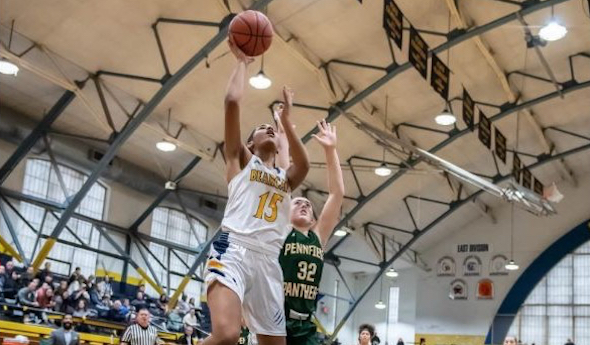
Hoops Finds Annual Home During Holidays
December 27, 2019
By Ron Pesch
Special for Second Half
Nothing says the Holidays like a high school basketball tournament.
It started, like many things do, with a drip. Well, make that a dribble.
The Michigan High School Athletic Association has allowed Holiday basketball tournaments for years. When was the first? That’s hard to establish. No one really kept track of such. A 1934 Wakefield News article indicates that a “Christmas Tournament will be held for the (Gogebic) Range teams at Wakefield December 27 and at Ironwood December 28.” Hurley, Bessemer, Ironwood and Wakefield were entered in the “blind” tournament, with opponents drawn just before game time. It was a new idea, at least in the Upper Peninsula.
“Nothing of its kind has ever been attempted in the Peninsula before,” stated the Ironwood Daily Globe. The tournament, won by Hurley, was a financial success. After expenditures, including the purchase of trophies, profit equaled enough that $22.42 was distributed to each school competing in the tournament. Plans were announced to bring back the tournament in a larger format the following year. It did return the following December, with the same teams in the same format but with all games played in Wakefield. This time out, Ironwood topped Hurley 22-21 for the tournament title.
In the Lower Peninsula in 1935, an All-Berrien County Holiday tournament was held Dec. 26, 27 and 28, with Three Oaks winning the Class B-C division title, 15-13 in the final over Berrien Springs. St. Joseph Catholic emerged as the Class D victor with a surprising 27-26 win over the reigning MHSAA state champ from Stevensville. The 14-team competition was played at Niles High School. Attendance was “slim, very slim” for the opening day of the tourney. The event did not return in 1936.
A similar, but much smaller, event was staged in Berrien County in 1941 with the Bridgman Class C Invitational. The tournament featured seven teams with contests spread over three nights. It was a success.
“Some 450 paid admissions were checked in Wednesday night for the championship finals, which Bridgman won from Berrien Springs. … The total paid admission for the three night event was 1,420 fans with a gross gate of approximately $400.”
By the mid-1940s, the idea of playing prep basketball during the Christmas lull had begun to take off across the state.
In December 1946, before a crowd of 1,500 at the Flint IMA Auditorium, Holland, the reigning Class A champion, downed Flint Northern 51-48 behind a pair of late field goals by Ken ‘Fuzz’ Bauman in the first annual Motor City Invitational. In Jackson, Detroit Catholic Central won the Michigan Catholic Invitational, beating Kalamazoo St. Augustine, 42-40. Bridgman again snagged the title at the Sixth Annual Berrien Class C Christmas Holiday Tournament. It was the Bees’ third Christmas championship in four years. The Little Eight Conference Holiday Tournament was played across four school gymnasiums as the calendar transitioned from 1946 to 1947. Bangor downed Covert, 34-29, in the championship contest hosted at Watervliet High School on Saturday, Jan. 4.
“Holiday tournament basketball has really caught on in Michigan,” said Hal Schram in the Detroit Free Press in 1947. “There will be no Christmas-New Year’s rest for at least 60 Michigan high school squads which have jumped at the chance to sharpen their collective shooting eyes for the long season ahead. … At last count, tournaments will be played between Dec 17 and Jan 3 at Flint, Saginaw, Grand Rapids, Jackson, Lincoln Park, Fremont, Negaunee, Marquette, Benton Harbor and Detroit.”
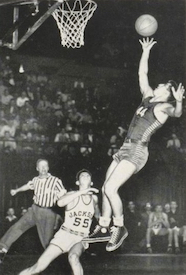 The same eight schools that played at the first Motor City tournament – Jackson, Grand Rapids Central, Holland, Muskegon Heights, Monroe, Midland, Flint Central and Flint Northern – were invited back for the second year. According to Schram, “Not a single participating school of a year ago wanted to be left out.”
The same eight schools that played at the first Motor City tournament – Jackson, Grand Rapids Central, Holland, Muskegon Heights, Monroe, Midland, Flint Central and Flint Northern – were invited back for the second year. According to Schram, “Not a single participating school of a year ago wanted to be left out.”
Jackson downed Flint Northern in the title game, 39-34.
The Saginaw Invitational, hosted at Arthur Hill High School, boasted six Class A schools as well as Alma and Mount Pleasant, both Class B schools. Mount Pleasant surprised the field, winning the tournament with a 40-25 triumph over Dearborn Fordson in the championship game.
A year later in December, Schram wrote, “The Michigan High School Athletic Association wasn’t caught unaware when the tournament bug started to bite every sector of the state.”
“Never did we expect such a wave of tournament play as we will see during the next three weeks,” said Charles Forsythe, state director for the MHSAA, noting 34 Christmas vacation tournaments were scheduled between December 15 and January 8 during the 1948-49 basketball season. “Perhaps we’re lucky at that. The Oklahoma association has had to sanction 123 tournaments.”
Forsythe and Schram explained the reasons for the wave of popularity. Of particular interest was the fact that, at the time, a school sponsoring both football and basketball could play a total of no more than 24 games, combined, in the two sports. However, MHSAA rules allowed a basketball team the chance to play as many as three games during a Holiday tournament and be charged with only one of its allotted combination of 24 contests. (The MHSAA rules changed prior to 1972-73 to allow basketball teams a maximum of 20 games.)
Coaches could keep their squads sharp during the two-week layoff with games rather than just mandatory practices. And, as a bonus to all because tournaments were financed through gate admissions, invitations to larger tournaments meant teams got to “stay and eat at the best hostelries, go on sightseeing tours when not playing and play non-conference opponents from other sections of the state.“
Add in the chance to play before larger-than-normal crowds, and the formula for a successful tournament was cast.
Beginning with the 1950-51 season, the football-basketball rule was altered to count play in mid-season invitational tournaments as two contests. With the change, according to the Detroit Times, “the number of such meets dropped sharply.”
Only nine Holiday tournaments, involving 50-plus teams, were recorded by the MHSAA during the 1951-52 season: the 5th annual Flint Parochial Invitational, the Alpena Catholic Invitational (involving 16 teams), the 5th Annual Greater Lansing Invitational, the Albion College Invitational, the Twin-Five Conference Christmas Tournament (a 10-team replacement for the disbanded Little Eight Conference’s tournament), the Otisville Invitational, the Columbiaville Invitational and the 1st Annual Portland St. Patrick Christmas Invitational.
But by the 1960s, Holiday Tournaments were again regaining popularity, with more now focused on teams from a specific community or section of the state, especially among smaller schools.
The St. Patrick tournament was still going strong in 1966 – its 15th year – with an eight-team, four-day design. Williamston downed a Cinderella squad from Carson City, 64-44, before 1,100 fans at Portland to earn the championship. Other Mid-Michigan holiday tournaments played out in Chelsea and Swartz Creek at the same time.
The Flint Parochial League Tournament was a mainstay of the Holiday season until the breakup of the league in the early 1970s.
“Basketball tournaments have become popular around the state and nation in recent years,” wrote Wendy Foltz, longtime Battle Creek Enquirer sports editor, before the kickoff of the inaugural Battle Creek Central Holiday Cage Tournament in 1968. In a twist that harkened back to earlier days, the eight-team event represented nearly every section of lower Michigan. “Battle Creek never has been a rabid basketball town like some around the state,” added a hesitant Foltz, noting a hope that the event could at least break even.
Hosted at the Cereal City’s historic Fieldhouse, built in 1928, that first tournament was won by host Battle Creek Central, which downed Traverse City 71-53 before a crowd of 2,000. Phil Todd led the Bearcats with 29 points, including 21 in the first half, while 6-foot-8 Tom Kozelko paced TC with 24. Muskegon Heights won the consolation game, holding off a late Ypsilanti Willow Run rally, 78-77. Other schools competing were Battle Creek Lakeview, Grand Blanc, Romulus and recently-opened Jackson Lumen Christi.
Chuck Turner, Central’s head coach, and junior varsity coach Jack Schils had contacted 60 schools during the summer of 1967 to organize the 12-game schedule.
“The response was terrific,” said Schils, who added, “Many schools could not accept because of schedule commitments but want to enter a year hence.”
The Battle Creek tournament was back in 1969, again hosting teams from near and far. Schils noted that cost ran high when teams were brought in from long distances: “However, this type of tournament is highly desirable so we hope fans will support it.”
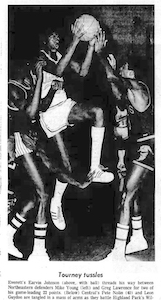
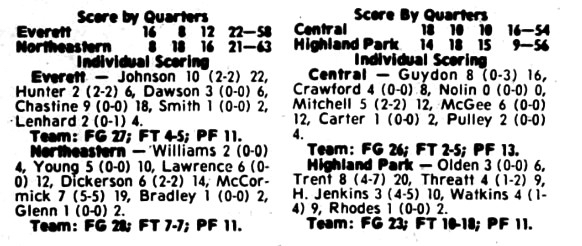 But the event was discontinued following the 1970-71 season when the “eight team format became too unwieldy,” according to the Enquirer “… and both crowd and the quality of play declined.”
But the event was discontinued following the 1970-71 season when the “eight team format became too unwieldy,” according to the Enquirer “… and both crowd and the quality of play declined.”
Pared down to a four-team format, it returned in a big way in December 1975. The tournament saw standing-room-only crowds of more than 3,000 for games between Battle Creek Central, Detroit Northeastern, Class A quarterfinalist Lansing Everett and reigning Class A champion Highland Park.
Detroit Northeastern downed Lansing Everett, 63-58 for the Cereal City championship trophy. Everett junior Earvin Johnson scored 22 points and, with teammate Reggie Chastine, was named to the all-tournament team along with Northwestern’s Wilbert McCormick, the tourney MVP, and his teammate Greg Lawrence. Highland Park’s William Trent and Battle Creek Central’s Leon Guydon also were named to the team.
By the 1980s, it seemed that the Christmas break nearly mimicked March in Michigan.
“I think a Christmas tournament really helps your program,” said Turner in 1980 to the Enquirer. He had taken over the head coaching position at Battle Creek in the fall of 1967 after a successful stint at Willow Run. “I don’t understand basketball teams having a preseason, playing three or four games, then taking two weeks off. When you get back, it’s like starting over.”
Besides Turner’s squad, the 1980 field included Detroit Western, Detroit Murray Wright and eventual winner Kalamazoo Central. The event would ultimately be re-christened the Battle Creek Central Chuck Turner Holiday Classic.
“The late Chuck Turner started bringing big games to the city over the holidays when he first started at the school in the 1960s,” wrote Bill Broderick in the Enquirer in 2018.
“Chuck started this because he wanted to give people the chance to come back home for the holidays and see everyone play. It’s been like a family reunion over the years,” Fred Jones told Broderick. Jones was a longtime assistant to Turner. “That we can keep it going in his name is great and hopefully we can keep if going for another 50 years.”
The girls are now part of the action. All five Battle Creek city schools – Central, Pennfield, Harper Creek, Lakeview, and St. Philip – were part of the event in 2018.
This year the Chuck Turner Central Field House Holiday Classic will again span two days – December 27 and 28 – and will again see all five city schools play on the historic floor.
Other Holiday tournaments scheduled this year include:
Petoskey Invitational – December 13-14
Raider Shootout – December 21
18th Annual Muskegon Area Sports Hall of Fame Classic – December 27
Earl McKee Classic – December 27-28
North Farmington Holiday Extravaganza – December 27
Motor City Roundball Classic – December 27
Cornerstone Invitational – December 27
Washtenaw Hoops Showcase – December 28
 Ron Pesch has taken an active role in researching the history of MHSAA events since 1985 and began writing for MHSAA Finals programs in 1986, adding additional features and "flashbacks" in 1992. He inherited the title of MHSAA historian from the late Dick Kishpaugh following the 1993-94 school year, and resides in Muskegon. Contact him at [email protected] with ideas for historical articles.
Ron Pesch has taken an active role in researching the history of MHSAA events since 1985 and began writing for MHSAA Finals programs in 1986, adding additional features and "flashbacks" in 1992. He inherited the title of MHSAA historian from the late Dick Kishpaugh following the 1993-94 school year, and resides in Muskegon. Contact him at [email protected] with ideas for historical articles.
PHOTOS: (Top) The Battle Creek Central and Pennfield girls face off during the 50th Chuck Turner Classic. (Middle) Shaheen Shaheen scores two points for Flint Northern, which fell to Jackson 39-34 during the 1947 Motor City championship game. (Below left) Lansing Everett’s Earvin Johnson makes a move toward the basket against Detroit Northeastern during the 1975 Battle Creek event. (Below right) Box scores from the 1975 tournament include Johnson’s 22 points in the 63-58 loss. Photos courtesy of the Battle Creek Enquirer, Lansing State Journal and Ron Pesch archives.)

